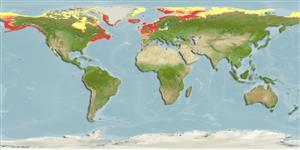Common names from other countries
Environment: milieu / climate zone / depth range / distribution range
Ecologia
; intervalo de profundidade 15 - 250 m (Ref. 95344). Polar; 85°N - 42°N, 169°W - 104°E
Arctic, Northern Atlantic and Northeast Pacific: UK and Europe; Russia, Alaska and northwest USA. Temperate to polar.
Length at first maturity / Tamanho / Peso / Idade
Maturity: Lm ? range ? - ? cm Max length : 5.0 cm SHL macho/indeterminado; (Ref. 95344)
This bivalve is a suspension feeder (Ref. 3477).
Life cycle and mating behavior
Maturidade | Reprodução | Desova | Ovos | Fecundidade | Larvas
Members of the class Bivalvia are mostly gonochoric, some are protandric hermaphrodites. Life cycle: Embryos develop into free-swimming trocophore larvae, succeeded by the bivalve veliger, resembling a miniature clam.
MarineSpecies.org. 2050. (Ref. 3477)
Categoria na Lista Vermelha da IUCN (Ref. 130435)
Categoria CITES (Ref. 108899)
Not Evaluated
Not Evaluated
Utilização humana
| FishSource |
Ferramentas
Mais informação
Idade/TamanhoCrescimentoComprimento-pesoComprimento-comprimentoMorfologiaLarvasAbundância
Fontes da internet
Estimates based on models
Preferred temperature
(Ref.
115969): 5.8 - 10.2, mean 7.6 (based on 315 cells).
Categoria de preço
Unknown.
